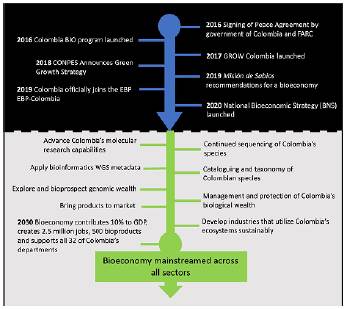As the 21st Century economies face the limitations of a finite planet such as peak oil and peak phosphorus, nations need to care for their citizens and their systems in sustainable and renewable ways. The greatest wealth of Colombia is found in its people and in its biodiversity. Colombian people from all walks of life are renowned for being resourceful and innovative and Colombian biodiversity ranks among the greatest on Earth. One solution to the economic challenges facing the country, therefore, may reside in its rich biodiversity.
In 2020, the Colombian government announced the National Bioeconomic Strategy (NBS) focused on the recent concept of bioeconomy where growth is generated through innovative new economic activities that sustainably utilize the vast biological resources of the country. The NBS has three synergistic initiatives that interact to promote bioeconomic activities for which the completion of the inventory of its biodiversity is very much needed, a target assigned to the "Colombia BIO" expeditions launched in 2016 and sponsored by the Ministry of Sciences with funds from oil royalties. The national goals established by the government need to be informed by scientists to identify priorities and develop goal-oriented strategies based on the country's biodiversity. This role has been filled by the Misión de Sabios, the scholars committee who recommended that over the next eight years the nascent bioeconomy should contribute at least 10% of the gross domestic product (GDP) of Colombia. Finally, the national planning department and the national social and economic policies board adopted in 2018 the initiative Misión de Crecimiento Verde (mission for green growth) to guide economic planning and development based on the efficient use of resources, promote the bioeconomy and expand the role of labor in green growth. Colombia, therefore, represents a special case of alignment and common purpose of the government, the academy, and the industry for the sake of bioeconomy. For this reason, Colombia was the subject of the only nation-specific article in the PNAS special feature issue of ten articles on the Earth BioGenome Project (EBP).
The NBS will accelerate bioeconomy in five ways, one of which is promoting a 'bio-intelligent' country that combines technological advances based on the knowledge of our biodiversity and its sustainable use. Areas of interest include pharmaceuticals, data science, and '-omics' fields such as genomics, proteomics, and metabolomics. Genomics is the characterization of life on earth at its most basic level: the complete DNA sequence. The EBP is an international consortium of scientists and institutions seeking to promote and complete a global inventory of eukaryotic genomes. Thus, the goals of the NBS and the EBP dovetail nicely and in such a framework, EBP-Colombia was established in 2019 as a multi-institution consortium to promote these shared interests and goals. EBP-Colombia is already supporting, directly and indirectly, three NBS goals: the collection of genomic data aimed at providing the most fundamental type of biodiversity characterization which will greatly help in resolving taxonomy and revealing adaptations of species to their environments, both activities targeted by the Colombian BIO initiative. One of the first EBP-Colombia projects focuses on the bivalve piangua genomic data to inform sustainable use of this important artisanal food source. The genomic data has other practical benefits for optimizing conservation efforts by revealing the historical demography and current genetic health of wild and captive populations at an unprecedented level of detail. Currently, an EBP-Colombia project is using genomics to characterize the genetic diversity and demographic history of the iconic and endangered Andean bear across Colombia. Finally, investing in genomic technologies, data generation, computational resources, and training will likely provide tremendous economic returns. EBP-Colombia is, therefore, committed to capacity building in the sense of training and knowledge, but also in the sense of access to in vitro and in silico technological resources with the goal of developing sustainable bioeconomic benefits. An ongoing example of this endeavor is using genomics to characterize and improve Colombian cocoa by using bioinformatics and molecular genetics tools to reduce cadmium uptake. Consequently, EBP-Colombia will serve an important role in fulfilling the NBS's goal of a biointelligent Colombia.















